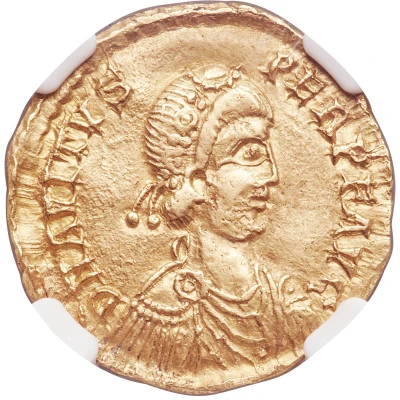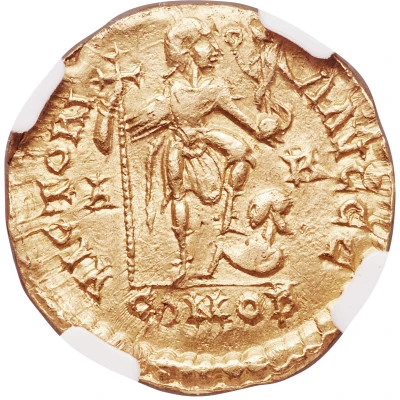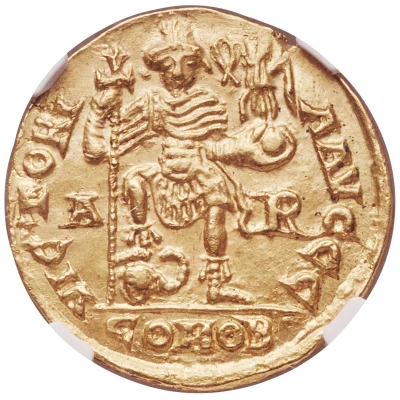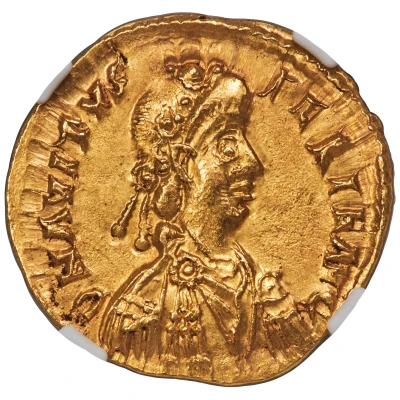
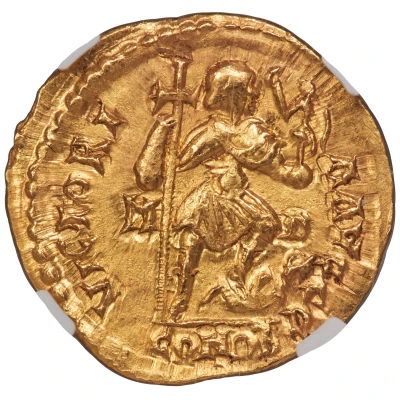

© Heritage Auctions
Solidus - Avitus VICTORIA AVGGG; Mediolanum
| Gold | 4.48 g | 21 mm |
| Issuer | Western Roman Empire (Rome) |
|---|---|
| Emperor | Avitus (455-456) |
| Type | Standard circulation coin |
| Years | 455-456 |
| Value | 1 Solidus |
| Currency | Solidus |
| Composition | Gold |
| Weight | 4.48 g |
| Diameter | 21 mm |
| Shape | Round (irregular) |
| Technique | Hammered |
| Orientation | Variable alignment ↺ |
| Demonetized | Yes |
| Updated | 2024-10-04 |
| Numista | N#373844 |
|---|---|
| Rarity index | 97% |
Reverse
Avitus standing facing in military dress, head right, grounded long cross in right hand, Victory on globe left in left, resting left foot on recumbent captive; M-D across fields, mintmark in exergue.
Script: Latin
Lettering:
VICTORI-A AVGGG
M D
COMOB
Comment
The brief, troubled reign of Marcus Maecilius Flavius Eparchius Avitus came against a backdrop of chaos, disintegration and intrigue in the dying West Roman Empire. Avitus was a Romano-Gallic nobleman of high standing who served as an envoy between the Roman Senate and the Visigoths who now ruled large swaths of Gaul and Spain. Upon the death of the usurper Petronius Maximus at Rome in AD 455, Avitus easily gained the support of the Visigothic king, Theodoric II, and was proclaimed emperor of the West at Arles in southern Gaul on July 9 or 10. An assembly of Gallo-Roman nobles ratified the elevation at Toulouse the following month, and the East Roman Emperor Marcian gave his approval in September. The aristocrats and common folk of Italy, however, viewed Avitus as a Gallic interloper and gave him a cool reception upon his arrival at Ravenna. Badly in need of military prestige, Avitus looked about for a capable general to lead his armies and found one in the Romanized barbarian Ricimer, who had won a naval battle against the Vandals off the coast of Corsica early in AD 456. But Ricimer had grand designs of his own. Appointed Master of Soldiers, he soon began intriguing with Majorian, the dashing Roman officer leading the army of Italy, to undermine Avitus' feeble regime. A severe famine in Italy only worsened the position of Avitus, whose Visigothic allies were now preoccupied with a war against the Suevi in Spain. Under pressure from the Italian bluebloods, Avitus dismissed his Gothic bodyguards and Gallic advisors, which only left him more vulnerable. The final coup d'etat came on October 17, AD 456, when Majorian and Ricimer withdrew their support and simply declared Avitus deposed. He fled Rome, hoping to make safe haven in Gaul, but was overtaken by Ricimer, forced to abdicate, and consecrated bishop of Piacenza (a common means of permanently removing someone from government service). He never lived to take up his clerical post, dying a few days or weeks later, either of natural causes or on Ricimer's orders. The rare coinage of Avitus reflects his Gallic origins, as most of the coins in his name appear to have been struck at the newly reopened mint of Arelate (modern Arles), where he was first acclaimed emperor.Interesting fact
One interesting fact about this coin is that it features an image of Emperor Avitus on one side and the goddess Victory on the other, symbolizing the imperial power and the victory of the Roman Empire.
